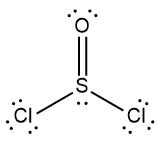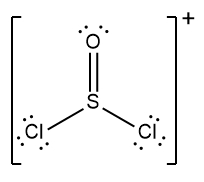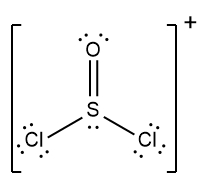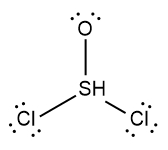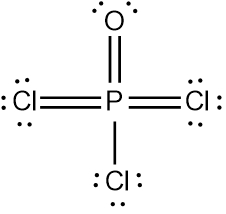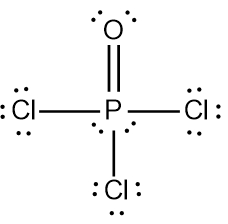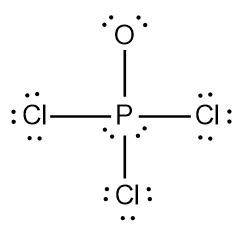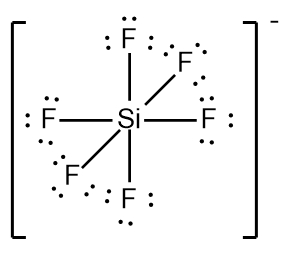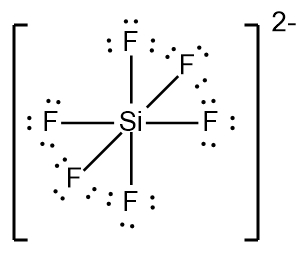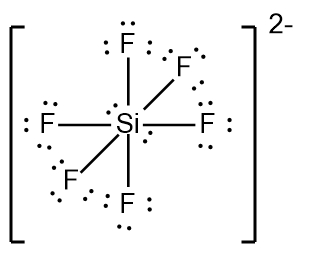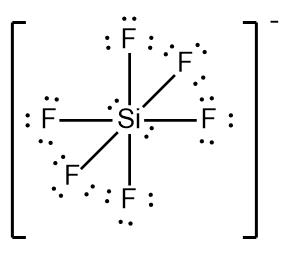Some elements can have less than 8 or more than 8 octet electrons around themselves and maintain stability. Now recall their non-octet number of electrons is \(2x\), where \(x\) is their group number. So, for incomplete octets where they have less than 8 octet electrons around them, for group 2A it'd be \(2 \times 2\), which is 4. For group 3A it'd be \(3 \times 2\) which is 6. Therefore, group 2A elements can have 4 octet electrons and be stable. Group 3A can have 6. We're just multiplying their group number by 2. So, group 5A could have 10 electrons and be okay, group 6A could have 12, 14, and 16. So, just remember, sometimes the octet rule is broken, and it's still okay in terms of the Lewis dot structure.
- 1. The Chemical World9m
- 2. Measurement and Problem Solving2h 25m
- 3. Matter and Energy2h 15m
- Classification of Matter18m
- States of Matter8m
- Physical & Chemical Changes19m
- Chemical Properties8m
- Physical Properties5m
- Temperature (Simplified)9m
- Law of Conservation of Mass5m
- Nature of Energy5m
- First Law of Thermodynamics7m
- Endothermic & Exothermic Reactions7m
- Heat Capacity16m
- Thermal Equilibrium (Simplified)8m
- Intensive vs. Extensive Properties13m
- 4. Atoms and Elements2h 33m
- The Atom (Simplified)9m
- Subatomic Particles (Simplified)12m
- Isotopes17m
- Ions (Simplified)22m
- Atomic Mass (Simplified)17m
- Periodic Table: Element Symbols6m
- Periodic Table: Classifications11m
- Periodic Table: Group Names8m
- Periodic Table: Representative Elements & Transition Metals7m
- Periodic Table: Phases (Simplified)8m
- Periodic Table: Main Group Element Charges12m
- Atomic Theory9m
- Rutherford Gold Foil Experiment9m
- 5. Molecules and Compounds1h 50m
- Law of Definite Proportions9m
- Periodic Table: Elemental Forms (Simplified)6m
- Naming Monoatomic Cations6m
- Naming Monoatomic Anions5m
- Polyatomic Ions25m
- Naming Ionic Compounds11m
- Writing Formula Units of Ionic Compounds7m
- Naming Acids18m
- Naming Binary Molecular Compounds6m
- Molecular Models4m
- Calculating Molar Mass9m
- 6. Chemical Composition1h 23m
- 7. Chemical Reactions1h 43m
- 8. Quantities in Chemical Reactions1h 16m
- 9. Electrons in Atoms and the Periodic Table2h 32m
- Wavelength and Frequency (Simplified)5m
- Electromagnetic Spectrum (Simplified)11m
- Bohr Model (Simplified)9m
- Emission Spectrum (Simplified)3m
- Electronic Structure4m
- Electronic Structure: Shells5m
- Electronic Structure: Subshells4m
- Electronic Structure: Orbitals11m
- Electronic Structure: Electron Spin3m
- Electronic Structure: Number of Electrons4m
- The Electron Configuration (Simplified)20m
- The Electron Configuration: Condensed4m
- Ions and the Octet Rule9m
- Valence Electrons of Elements (Simplified)5m
- Periodic Trend: Metallic Character4m
- Periodic Trend: Atomic Radius (Simplified)7m
- Periodic Trend: Ionization Energy (Simplified)9m
- Periodic Trend: Electron Affinity (Simplified)7m
- Electron Arrangements5m
- The Electron Configuration: Exceptions (Simplified)12m
- 10. Chemical Bonding2h 10m
- Lewis Dot Symbols (Simplified)7m
- Ionic Bonding6m
- Covalent Bonds6m
- Lewis Dot Structures: Neutral Compounds (Simplified)8m
- Bonding Preferences6m
- Multiple Bonds4m
- Lewis Dot Structures: Multiple Bonds10m
- Lewis Dot Structures: Ions (Simplified)8m
- Lewis Dot Structures: Exceptions (Simplified)12m
- Resonance Structures (Simplified)5m
- Valence Shell Electron Pair Repulsion Theory (Simplified)4m
- Electron Geometry (Simplified)7m
- Molecular Geometry (Simplified)9m
- Bond Angles (Simplified)11m
- Dipole Moment (Simplified)14m
- Molecular Polarity (Simplified)7m
- 11 Gases2h 15m
- 12. Liquids, Solids, and Intermolecular Forces1h 11m
- 13. Solutions3h 1m
- 14. Acids and Bases2h 14m
- 15. Chemical Equilibrium1h 27m
- 16. Oxidation and Reduction1h 33m
- 17. Radioactivity and Nuclear Chemistry53m
Lewis Dot Structures: Exceptions (Simplified) - Online Tutor, Practice Problems & Exam Prep
 Created using AI
Created using AILewis Dot Structure Exceptions happen when the central element violates the Octet Rule.
Lewis Dot Structure Exceptions
Lewis Dot Structures: Exceptions (Simplified) Concept 1
Video transcript
Group 2A and 3A elements have incomplete octets. Group 5A-8A elements can have expanded octets.
Lewis Dot Structures: Exceptions (Simplified) Example 1
Video transcript
Here we have to draw the Lewis dot structure for xenon dibromide molecule. So xenon is in group 8A, it's a noble gas, so it has 8 valence electrons. Bromine is in group 7A, so it has 7, and there are 2 of them. So we have a total of 22 valence electrons. Now xenon will go in the center, and here we're going to be connected to our 2 bromines. Now remember, your surrounding elements need to follow the octet rule. So we're going to put our electrons around bromines so that they each have 8 total valence electrons. Three lone pairs around them, totaling 6 electrons. Remember, they're also sharing electrons from the single bond, so that's 8 each one has. So that's using up 16 of my total 22 valence electrons. So, we have 6 remaining. Here, the remaining 6 electrons, we have no choice but to put them around xenon. So 6 electrons and we separate them evenly as lone pairs, and this would be the structure of xenon dibromide molecule. We can see here that xenon has 2, 4, 6, 8, 10 electrons around it. It's breaking the octet rule because it is an exception. Now its ideal non-octet number would have been 16, but again, that's when it's ideal. Here, we just don't have enough electrons to get to that number of 16. Instead, xenon is okay with having 10 electrons around it. But here we're seeing that our central element is breaking the octet rule, and it's still okay.
Determine the Lewis Dot Structure for the following compound:SOCl2
Lewis Dot Structures: Exceptions (Simplified) Concept 2
Video transcript
When we discuss electron molecules, we typically talk about free radicals. Now, free radicals are molecules or ions with a single unpaired electron around an element. We're going to say that these radical compounds or radical molecules always have an odd number of total valence electrons. What's important to understand here is that to draw them, we place the electron on the element that is less electronegative, except in the case of hydrogen itself. That's because if we show a similar electron around hydrogen, it would be breaking the octet rule or in this case, the duet rule where it wants only 2 electrons around it.
So, if we take a look here at this molecule of nitrogen monoxide, we have a lone electron here that's unpaired on the nitrogen. Nitrogen is less electronegative than oxygen, so that's why it has the lone electron. And how do we know that nitrogen monoxide is a radical compound? Again, we would look at the total number of valence electrons and see if it's an odd number. Nitrogen is in group 5a, so it has 5 valence electrons. Oxygen is in group 6a, so it has 6 valence electrons. So, the total number of valence electrons for nitrogen monoxide is 11 electrons. So it's an odd number, and that's why we have a radical molecule or compound in this case. So just keep in mind when we deal with these radical or free radical compounds, this is what you need to be on the lookout for to determine if it is a radical or not.
Radical compounds always have an odd number of total valence electrons.
Lewis Dot Structures: Exceptions (Simplified) Example 2
Video transcript
Here it says, "Draw the Lewis Dot structure for the radical of nitrogen dioxide." So, nitrogen dioxide is a very common example used to talk about radicals. If we look at the total number of valence electrons, we have 5 from nitrogen, since it's in group 5A, and 6 times 2 for the oxygen, since oxygen is in group 6A, so it has 6 and there are 2 of them. This gives a total of 17 valence electrons. It's an odd number of valence electrons, so that's a strong indication we're dealing with a radical.
We place nitrogen in the center, it forms single bonds with the oxygens initially, making sure that the surrounding elements follow the octet rule. Right now, we have a total of 16 electrons depicted, leaving us with 1 electron left. The issue now is that nitrogen is not fulfilling the octet rule. It has 2, 3, 5 electrons around it. So remember, when an element is not fulfilling the octet rule, what we can do is make double or triple bonds. Here, we can't make a triple bond because then that would be too many electrons around nitrogen. It can only go up to 8 for the octet rule. So, we're just going to use one of the lone pairs on either oxygen to make a double bond. In that way, nitrogen has 7 electrons around it, and that's the best that we can do. This here depicts what the nitrogen dioxide molecule would look like. It is a radical because we have that one lone electron on top of nitrogen.
Draw the Lewis Dot Structure for the radical hydroxide, OH.
Draw the Lewis Dot Structure for POCl3.
Metalloids can sometimes adopt the bonding preferences of similar nonmetals. Based on your knowledge of expanded octets, draw the Lewis Dot Structure for the following ion, SiF62–.
Here’s what students ask on this topic:
What are the exceptions to the octet rule in Lewis dot structures?
Some elements can have fewer or more than 8 electrons in their valence shell and still be stable. For example, elements in group 2A can have 4 electrons (2 × 2), and elements in group 3A can have 6 electrons (3 × 2). Additionally, elements in groups 5A and 6A can have 10, 12, 14, or even 16 electrons. These exceptions occur because the octet rule is not a strict requirement for all elements, especially those beyond the second period of the periodic table.
 Created using AI
Created using AIHow do you identify a free radical in a molecule?
Free radicals are molecules or ions with a single unpaired electron, resulting in an odd number of total valence electrons. To identify a free radical, count the total number of valence electrons in the molecule. If the number is odd, the molecule is a free radical. For example, nitrogen monoxide (NO) has 11 valence electrons (5 from nitrogen and 6 from oxygen), making it a free radical.
 Created using AI
Created using AIWhy can some elements have more than 8 electrons in their valence shell?
Elements beyond the second period of the periodic table can have more than 8 electrons in their valence shell due to the availability of d-orbitals. These elements can expand their valence shell to accommodate more electrons, leading to stable configurations with 10, 12, or more electrons. This is why elements in groups 5A and 6A can have 10, 12, 14, or even 16 electrons.
 Created using AI
Created using AIHow do you draw Lewis dot structures for molecules with incomplete octets?
For molecules with incomplete octets, the number of valence electrons is less than 8. For example, elements in group 2A can have 4 electrons, and elements in group 3A can have 6 electrons. To draw these structures, distribute the available electrons around the central atom, ensuring that the total number of electrons matches the group number multiplied by 2. For instance, beryllium (group 2A) can have 4 electrons in its valence shell.
 Created using AI
Created using AIWhat is the significance of free radicals in chemical reactions?
Free radicals are highly reactive due to their unpaired electron. They play a crucial role in various chemical reactions, including combustion, polymerization, and biological processes. In organic chemistry, free radicals can initiate chain reactions, leading to the formation or breaking of chemical bonds. Understanding free radicals is essential for studying reaction mechanisms and the stability of radical compounds.
 Created using AI
Created using AI